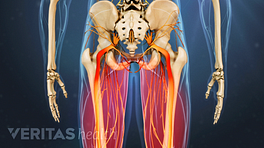For patients with symptomatic isthmic spondylolisthesis, the most common symptoms include:
- Low back pain, often described as a deep ache in the lower back
- Pain that radiates into the buttocks and back of the thighs, (also called radicular pain)
- Pain that is worse when standing, walking, or any type of activities that involves bending backwards
- Pain that feels better with sitting, especially sitting in a reclining position
- A tired feeling in the legs, and possibly leg numbness or tingling, especially after walking
- Pain that radiates below the knee and possibly into the foot.
This article is all about the symptoms of isthmic spondylolisthesis, also view: Degenerative Spondylolisthesis Symptoms
In addition to the above pain-related symptoms, most patients with isthmic spondylolisthesis have tight hamstrings - the large muscle that runs down the back of the thigh - making it difficult for them to touch their toes.
See Specific Hamstring Stretches for Back Pain Relief to help with tight hamstrings.
Grade 2, Grade 3, Grade 4 Spondylolisthesis Symptoms
In addition to the above symptoms, patients with a grade two or higher slippage usually have a fairly recognizable deformity to their low back, especially if the slip is accompanied by a very vertical angle. For example:
- The patient will appear to have a short trunk and a large abdomen.
- He or she will have an accompanying large lordosis (sway to the low back), and a vertical pelvis.
- Often the patient's hamstrings will become very tight, which in turn leads to a waddling gait.
Rarely, patients may also have symptoms of cauda equina syndrome, such as progressive numbness or weakness in the legs, altered sensation in the saddle area between the legs, and difficulty controlling the bowl and/or bladder. If such symptoms are present, the patient should seek emergency medical attention.







